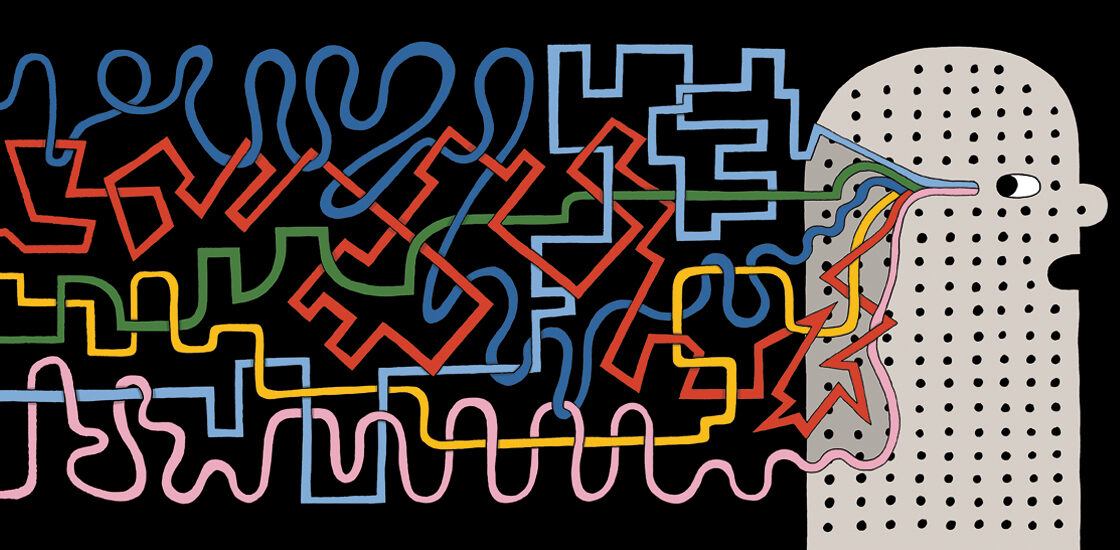But it has also suggested that the role of the thalamus in autism extends beyond the sensory world. New research reveals that the thalamus influences functions as diverse as sleep, social cognition, attention and learning.
“The thalamus plays a role in a lot of cognitive functions that are implicated in autism, so that’s why it’s a no-brainer to study it,” says Antonio Hardan, professor of psychiatry and behavioral sciences at Stanford University in California.
Studies of the thalamus’ role in autism have also expanded what is known about the region’s structure, assigning distinct functions to subregions and illuminating how it collaborates with the rest of the brain. Connections between the thalamus and autism genes and traits “lead us to think a lot harder about what does the thalamus do,” says Guoping Feng, professor of brain and cognitive sciences at the Massachusetts Institute of Technology in Cambridge.
Leaky filter:
It has long been thought that the thalamus’ job is to transmit signals from the eyes, ears and other sensory organs to the cerebral cortex, the outer layer of the brain, where the information is processed. By the mid-2000s, researchers had established that signals from the thalamus help determine how parts of the cortex become tuned to certain sensory stimuli in developing mice, underscoring the structure’s role in how the brain matures.
“This just really suggested that the thalamus might play some role in atypical development, atypical functional specialization of the cerebral cortex in autism,” says Ralph-Axel Müller, professor of psychology at San Diego State University in California.
Soon, scientists documented atypical communication between the thalamus and the cortex in people with autism. In 2006, Müller and his team reported that autistic people have unusually strong functional connectivity — a measure of how synchronized two brain regions are in their activity — between the thalamus and parts of the cortex. Other studies have since shown alterations in connectivity between the thalamus and the cortex in autism.
Researchers have amassed ample evidence that the thalamus contributes to unusual sensory responses in people with autism. For example, the stronger the connections between the thalamus and the auditory cortex, the more sensitive to sounds an autistic person tends to be, Müller’s team reported in 2018. And a study of 38 children, half of whom were autistic, showed unusual communication between the thalamus and the cerebral cortex in the autistic children when they were exposed to loud traffic noise and a scratchy piece of fabric rubbed on their arm.
Alterations in brain chemistry provide more support for a central role for the thalamus in autism. The thalamus of people with autism contains low levels of N-acetyl aspartate, a marker of neuronal integrity, and shows other chemical differences from that of controls, Hardan and his colleagues reported in 2018. Two years later, the researchers reported a potential deficit in concentrations of gamma-aminobutyric acid (GABA), a signaling molecule that dampens brain activity, in both the thalamus and the prefrontal cortex in adults with autism. Low levels of GABA in neural circuits linking the thalamus and cerebral cortex have also been associated with sensory sensitivity in people with autism, in which typical sensory stimuli become bothersome or overwhelming.
A lack of GABA may make the thalamus not only more responsive to stimuli but also less selective in the information it passes along, says Michael Halassa, professor of brain and cognitive sciences at the Massachusetts Institute of Technology. That is, the thalamus is not only a relay station but also a filter, responsible for amplifying important sensory information and tuning out what’s not important. And a “leaky” thalamic filter may help explain the difficulties some autistic people have focusing on a particular conversation at a party, for example, or tuning out the sound of a ticking clock, Halassa says.
This filtering function also helps regulate sleep, in part by tamping down sensory inputs when people are sleeping. A thalamus that does not filter out stimuli during slumber could spur insomnia or other sleep problems, which are common in autistic people. In support of this notion, young autistic children with atypically strong connections between the thalamus and the cerebral cortex also tend to have more sleep problems than those with weaker connections, Müller’s team showed in July.

Social piece:
Psychologist Aarti Nair has been investigating functional connectivity between the thalamus and the cerebral cortex in people with autism since she was a graduate student in Müller’s lab in the early 2010s. Her studies suggest a pattern of overconnectivity between the thalamus and sensory areas of the cortex, and underconnectivity with areas involved in social cognition, memory and planning, such as the prefrontal cortex. The work is part of a growing body of evidence that that the thalamus’ role in autism extends to emotion, cognition and regulation of social behavior.
‘Baby sibs’ — children who have an older autistic sibling — show this pattern of altered connectivity between the thalamus and cortex by the age of 6 weeks, Nair and her colleagues reported in September. Nair and Müller’s earlier studies in older children (ages 7 to 17 years) link this altered connectivity to social difficulties in autistic people as well as to some of their issues with executive function, which includes the impulse control and cognitive flexibility necessary for smooth social interactions. “That social piece is really kind of sticking out,” says Nair, now assistant professor of psychology at Loma Linda University in California.
Studies in mouse models of autism also support a role for the thalamus in social behavior. Researchers reported in 2017 that activity in a circuit that links the prefrontal cortex and a part of the thalamus called the mediodorsal thalamus is weaker than normal in three mouse models of autism and is associated with changes in social behavior in one of the mouse models (social behavior has not been tested in the other two). But surprisingly, inhibiting the circuit — rather than enhancing its activity — eases these social problems.
“It made me think, ‘Gosh, maybe these changes that I’m seeing at the level of the cortex really are compensatory changes,’” says Audrey Brumback, assistant professor of neurology and pediatrics at the University of Texas at Austin. In other words, alterations in cortical function may be compensating for atypical activity deeper in the brain. This idea also suggests a new strategy for therapy: Perhaps in some cases, “it’s not that we want to reverse the things that the brain is doing. Actually, we might want to boost those things,” she says.
Brumback has since identified some of the specific neurons involved in these effects. She and her colleagues found diminished activity in a set of neurons that send signals from the thalamus to the prefrontal cortex in one of the autism mouse models. In other experiments in wildtype mice, the researchers showed that activating these same neurons that link the mediodorsal thalamus and the medial prefrontal cortex makes the animals less social; they spend less time investigating other mice. Taken together, these results suggest that input from the thalamus is necessary for the prefrontal cortex to regulate social behavior.
The thalamus’ conversations with the prefrontal cortex may also underlie restricted interests and repetitive behaviors in autism, other researchers speculate. A malfunctioning thalamus may be unable to help tamp down the impulse to repeat a behavior or to fixate on something when it’s time to move on, Hardan says. He is investigating this hypothesis by looking for associations between repetitive behaviors and alterations in brain chemistry in the thalamus and other brain areas.
Divide and conquer:
Brumback and others are also working to understand the anatomy of the thalamus, which is made up of many subunits, or nuclei. Each nucleus has connections to specific parts of the brain, and likely distinct functions that may affect particular autism traits. “It’s a relatively small structure that is incredibly complex in its functional organization,” Müller says.
Brumback’s work points to a role in social behavior for the mediodorsal thalamus, whereas other nuclei seem to govern aspects of learning, attention and other cognitive functions. In a 2016 study, Feng, Halassa and their colleagues showed that mice lacking the autism-linked gene PTCHD1 in the thalamic reticular nucleus are hyperactive and inattentive, hinting that this subregion may play a role in attention. Knocking down PTCHD1 in a different nucleus, the anterodorsal thalamus, causes learning and memory problems in the mice, Feng and his colleagues reported in August. Disrupting several other autism genes in the anterodorsal thalamus produces similar results, further pointing to a cognitive function for this part of the structure.
In both experiments, the team identified drugs that could reverse the attention or memory problems in the mice. Ultimately, a more precise understanding of the functions of thalamic nuclei could help researchers treat specific difficulties in autistic people, researchers say. A drug aimed at neurons in the thalamic reticular nucleus could address issues with focus, for example, or deep brain stimulation might modulate activity in the mediodorsal thalamus to boost social skills.
The list of possible strategies is long, given the thalamus’ many functions and connections to almost every part of the brain. “I was thinking about: Is there anything that the thalamus doesn’t do, that it’s not involved in?” Brumback says. “And I couldn’t think of anything.”
Cite the article: https://doi.org/10.53053/HNKB4296
Source: Brain’s sensory switchboard has complex connections to autism | Spectrum | Autism Research News













